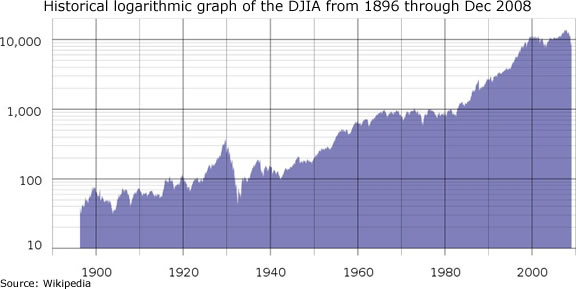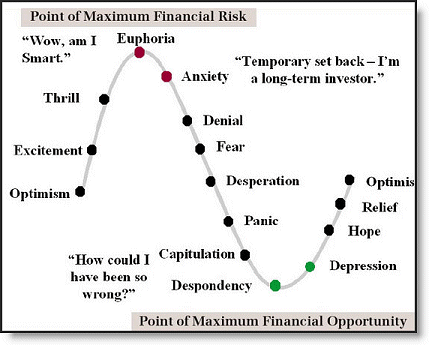I posted yesterday about the cyclic nature of the stock market, and I wanted to take some time today to go into further detail about market cycles. If you look at a historical chart of the Dow Jones Industrial Average, you see that the motion of the stock market is far from smooth. The gradual climb of the market over the past century is comprised of countless bull and bear markets spikes and dips.
But the most important thing to understand, as I explained yesterday, is that the market does not move on its own. The market moves because of the mindset and actions of individual investors. The market is not a living being, and it does not have a consciousness. The motion of the stock market is a manifestation of the collective consciousness of all its shareholders. In other words, the thoughts, emotions, and actions of each individual shareholder add up to produce the stock market. The stock market can seem like a very complicated and intimidating concept. But if you can understand the thoughts and actions of the typical trader, you can understand the entire stock market.
The emotional roller coaster that the typical trader endures throughout a market cycle is explained in something called the investor sentiment cycle. I go into great detail about the investor sentiment cycle in the chapter on market psychology in my book. The reason I focus so much on the investor sentiment cycle is because understanding where you are in the cycle and interpreting the meaning of your emotions is the single most important part of stock trading. Here is an excerpt from my book:
…As I have said before, a stock’s price is determined by how much investors believe it is worth. While the market may be efficient in pricing stocks to investors’ perceived values, the investors themselves are not nearly as efficient in figuring out how much a share of stock is worth to them. The psychology of investing in the market is the reason so many opportunities are created. One of the most helpful graphics I have come across over the past few years is the chart included below of the investor sentiment cycle. Remember that Warren Buffett said, “Be fearful when others are greedy and greedy when others are fearful.” The wisdom of this quote can easily be understood when looking at the investor sentiment cycle graphic.
The idea behind the investor sentiment cycle is that human emotions are backward-looking. When holding a position in a stock, we have emotional reactions to changes that have already occurred. When a stock falls, we get angry or scared. When it climbs, we feel excited and confident. The problem is that these emotions often lead us astray. I have asserted several times in this book that there is no way to make money off of the past. Take a look at the investor sentiment cycle. The cycle represents a typical price cycle of a stock that is trading essentially flat over time. Notice that the stock price at the end of the cycle is the same as the stock price at the beginning. Looking at the cycle as a whole, an objective observer would see no need to have an emotional response to the cycle at all. The stock bounced around and then ended up where it started: no gain, no loss. Big deal, right? However, human emotions occur in real time. If the first stock you buy starts moving up, you will feel overjoyed. “This is easy!” you might think. “I am great at picking stocks!” The challenge at this point, the peak in the investor sentiment cycle, is to keep yourself from buying more expensive stock. You feel great emotionally because you can look back and see how much money you’ve made. It will be a fun experience, and you will want the fun to continue. However, this is the point where Warren Buffet would be selling. You’ve made your money, now cash out! If you hold on too long, your stock will begin to drop and you will start to worry. “It will go back up,” you will tell yourself, “This is just a bump in the road!” As it continues to drop, you might start feeling scared or overwhelmed. “What is happening?!?!” you will ask. “How could I have lost all of this money???” If this sounds familiar, this is exactly what I felt the first couple of times I traded…
There are two sides to the stock market: an analytical side and an emotional side. No matter how good you are at analyzing stocks, if you cannot control your emotions throughout market cycles, you will inevitably lose your money. One of the reasons why so many people claim that the stock market is “rigged” or “fixed” or “unfair” is that our normal human emotions tend to lead us astray when it comes to stock trading. Once you remove your emotions from your trading, it is much easier to recognize the opportunities when other traders are virtually throwing fistfuls of their money at you because they are blinded by fear or greed.
Anyone can use the methods I learned and included in my book to harness their emotions and maintain the appropriate discipline throughout market cycles. I don’t have a degree in finance; I have a degree in neuroscience. You don’t have to predict what stocks will do if you can predict what traders will do and be one step ahead of them. I made a 400% return in the stock market in five years using only basic principles of psychology and common sense. To read about how I did it, check out my book, Beating Wall Street with Common Sense, and stay tuned to tradingcommonsense.com!



